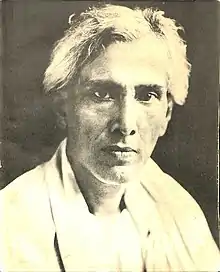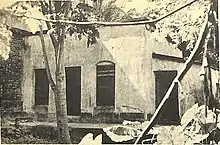Sarat Chandra Chattopadhyay
Sarat Chandra Chattopadhyay, alternatively spelt as Sarat Chandra Chatterjee (15 September 1876 – 16 January 1938), was a Bengali novelist and short story writer of the early 20th century. Most of his works deal with the lifestyle, tragedy and struggle of the village people and the contemporary social practices that prevailed in Bengal. He remains the most popular, translated, and adapted Indian author of all time.[1][2]
Sarat Chandra Chattopadhyay | |
|---|---|
 | |
| Born | 15 September 1876 Debanandapur, Hooghly district, Bengal Presidency, British India (now in West Bengal, India) |
| Died | 16 January 1938 (aged 61) Calcutta, Bengal Presidency, British India (now Kolkata, West Bengal) |
| Occupation | Writer, novelist |
| Language | Bengali |
| Nationality | British Indian |
| Period | 19th century-20th century |
| Literary movement | Bengali Renaissance |
| Notable works | Srikanta Choritrohin Devdas Parineeta Pother Dabi |
| Notable awards | Jagattarini award by Calcutta University |
| Spouse | Shanti devi (m. 1906–1908) Hironmoyi devi (m. 1910–1938) |
| Signature | |
| Website | |
| sharat | |
Biography
Sarat Chandra Chattopadhyay was born on 15 September 1876,[3] in Debanandapur, a small village in Hooghly, West Bengal.[4]

Sarat Chandra was a daring, adventure-loving boy. His education began at Pyari Pandit's pathshala, an informal village school and later he joined Hooghly Branch High School.[5] He was a good student and got a double promotion that enabled him to skip a grade.[6] He passed his Entrance Examination (public examination at the end of Class X) but could not take his F.A. (First Arts) examination or attend college due to lack of funds.[7]
House of Chattopadhyay
After returning from Burma, Chattopadhyay stayed for 11 years in Baje Shibpur, Howrah. Then he made a house in the village of Samta, in 1923, where he spent the later twelve years of his life as a novelist. His house is known as Sarat Chandra Kuthi. The two-storied Burmese style house was also home to Sarat Chandra's brother, Swami Vedananda, who was a disciple at Belur Math. His and his brother's samadhi are within the house's compound. Trees like bamboo and guava planted by the renowned author still stand tall in the gardens of the house.[8]
Appreciation
The phenomenal popularity of Sarat Chandra Chattopadhyay has been attested by some of the most prominent writers as well as literary critics across India in their writings.[9] Most of the authors in Assam and Odisha, at least before the Independence, read him admiringly in original Bengali; rest of India read him in translations in varying quality. Publishers were never tired of reprinting his works; he remains the most translated, the most adapted and the most plagiarized author.[9] His novels also reached a number of people through the medium of film and he is still an important force in Indian cinema. O. N. V. Kurup[9] writes "...Sarat Chandra's name is cherished as dearly as the names of eminent Malayalam novelists. His name has been a household word". Dr Mirajkar[10] informs "the translations of Sarat Chandra created a stir amongst the readers and writers all over Maharashtra. He has become a known literary personality in Maharashtra in the rank of any popular Marathi writers including H. N. Apte, V. S. Khandekar, N. S. Phadke and G. T. Madkholkar". Jainendra Kumar,[9] who considers that his contribution towards the creation and preservation of cultural India is second, perhaps, only to that of Gandhi, asks a rhetorical question summing up Sarat Chandra's position and presumably the role of translation and inter-literary relationship: "Sarat Chandra was a writer in Bengali; but where is that Indian language in which he did not become the most popular when he reached it?"
Films
His works have been made into around fifty films in many Indian languages.[9] Particularly, his novel Devdas has been made into sixteen versions, from Bengali, Hindi to Telugu. Parineeta has also been made twice. In 1957 Bardidi was made by director Ajoy Kar. Rajlakshmi O Srikanta and Indranath Srikanta O Annadadidi by Haridas Bhattacharya in 1958 and 1959 respectively, Majhli Didi (1967) by Hrishikesh Mukherjee and Swami (1977), for which he was awarded the Filmfare Award for Best Story, are other adaptations. Another famous film Chhoti Bahu (1971) is based on his novel Bindur Chhele. His novel 'Datta' was adapted into a Bengali film as Datta (film) in 1951 directed by Saumyen Mukhopadhyay starring Sunanda Banerjee and Manoranjan Bhattacharyya in the lead roles with Ahindra Choudhury as Rashbehari,[11][12] and again in 1976 starring Suchitra Sen and Soumitra Chatterjee in the lead roles. The film Sabyasachi (film) was released in 1977 based on his work Pather Dabi. The other movies based on his novel were Nishkriti, and Apne Paraye (1980) by Basu Chatterjee, starring Amol Palekar.[13] The Telugu film Thodi Kodallu (1957) is also based on this novel. Gulzar's 1975 film, Khushboo is majorly inspired by his work Pandit Mashay. The 1961 Telugu film Vagdanam by Acharya Atreya is loosely based on his novel Datta. Also the 2011 film Aalo Chhaya is based on his short story, Aalo O Chhaya.
Bibliography
Sarat Chandra wrote novels, novellas, and stories.[14]
His first novel was Badadidi (1907), which was published in the Bharati and made him well known. He went on to write several stories and novels, including
- Bindur Chhele O Anyanya (1914)
- Parinita (1916)
- Baikunther Will (1916)
- Pallisomaj (1916)
- Devdas (1917)
- Choritrohin (1917)
- Nishkrti (1917)
- Shrikanta (Part 1–4, 1917–1933)
- Datta (1918)
- Grihadaha (1920)
- Dena-Paona (1923)
- Pother Dabi (1926)
- Shes Proshno (1931)
He also wrote essays, which were anthologized in Narir Mulya (1923) and Svadesh O Sahitya (1932). Shrikanta, Charitrahin, Devdas, Grihadaha, Dena-Paona and Pather Dabi are among his most popular works. Pather Dabi was banned by the British Government because of its revolutionary theme. His posthumous publications include Chhelebelar Galpa, Shubhada (1938), Sheser Parichay (1939), Sharat Chandrer Granthabali (1948) and Sharat Chandrer Aprakashita Rachanabali (1951).
He wrote some essays including Narir Itihas (The History of Women) and Narir Mulya (The Value of Women). Narir Itihas, which was lost in a house fire, contained a history of women on the lines of Spencer's Descriptive Sociology. While the second, Narir Mulya gives a theory of women's rights in the context of Mill's and Spencer's arguments.[15]
Stories
- Aalo O Chhaya
- Abhagir Swargo
- Anupamar Prem
- Anuradha
- Andhare Aalo
- Balya Smriti
- Bilashi
- Bindur Chhele, (Bindu's Son) 1913
- Bojha
- Cheledhora
- Chobi
- Darpochurno (Broken Pride)
- Ekadoshi Bairagi
- Kashinath
- Haricharan
- Harilakshmi
- Lalu (parts 1, 2, and 3)
- Mamlar Phol
- Mandir
- Mahesh (The Drought)
- Mejdidi
- Bochor Panchash Purber Ekti Kahini
- Paresh
- Path Nirdesh
- Ramer Shumoti, (Ram's Good Sense) 1914
- Sati
- Swami (The Husband)[16]
Plays Sarat Chandra converted three of his works into plays.
- Bijoya
- Rama
- Shoroshi
- Jai hind
Essays
- Narir Mulya
- Swadesh O Sahitya
- Taruner Bidroho
Other works
- Dehati Samaj, 1920
- Sharoda (published posthumously)
Biography
See also
- Films based on works by Sarat Chandra Chattopadhyay
- Samtaber, the village where Sarat Chandra spent his life's early years as a novelist
- Sarat Chandra Kuthi, the house of Sarat Chandra at Samtaber
References
- "A History of Indian Literature 1911–1956: Struggle for Freedom: Triumph and Tragedy|South Asia Books (1 September 1995)". Retrieved 9 April 2015.
- "Sarat Chandra Chattopadhyay — Vagabond Messiah | FCCI". Journal of Indian Cinema. 15 September 2020. Retrieved 26 October 2020.
- Sarker, Subhash Chandra (January–February 1977). "Sarat Chandra Chatterjee: The Great Humanist". Indian Literature. New Delhi: Sahitya Akademi. 20 (1): 50. JSTOR 24157548.(subscription required)
- George, K. M., ed. (1997). Masterpieces of Indian literature. New Delhi: National Book Trust. p. 187. ISBN 978-81-237-1978-8.
- Suresh, edited by Sushama (1999). Who's who on Indian stamps (1st ed.). Santa Cruz de Tenerife (Angel Guimera, 11): Mohan B. Daryanani. p. 73. ISBN 8493110108.CS1 maint: extra text: authors list (link) CS1 maint: location (link)
- "শরৎ রচনাবলী | Sarat Rachanabali". www.sarat-rachanabali.nltr.org. Retrieved 30 October 2015.
- Sinha, BY J. N. (9 January 2015). "The mortals of Devdas".
- House of Sarat Chandra Archived 23 August 2011 at the Wayback Machine
- "A History of Indian Literature 1911–1956: Struggle for Freedom: Triumph and Tragedy|South Asia Books (1 September 1995)". Retrieved 9 April 2015.
- "A History of Indian Literature 1911–1956: Struggle for Freedom: Triumph and Tragedy|South Asia Books (1 September 1995)". Retrieved 9 April 2015.
- YouTube
- Moviebuff
- Gulzar; Govind Nihalani, Saibal Chatterjee (2003). Encyclopaedia of Hindi Cinema. Popular Prakashan. p. 337. ISBN 81-7991-066-0.
- "Remembering Sarat Chandra Chattopadhyay, the 'Awara Masiha'". The Indian Express. 15 September 2015. Retrieved 30 October 2015.
- Shandilya, Krupa (2017). Intimate Relations: Social Reform and the Late Nineteenth-Century South Asian Novel. Northwestern University Press. p. 46. ISBN 978-0-8101-3424-9 – via Project MUSE.(subscription required)
- "Classic Saratchandra | Penguin Books India". penguinqa.srijan-sites.com. Retrieved 30 October 2015.
- "Hindi Belt: A glimpse into an unfamiliar world". The Hindu. 23 January 2015. Retrieved 30 October 2016.
- "Remembering Sarat Chandra Chattopadhyay, the 'Awara Masiha'". Indian Express. 15 September 2015. Retrieved 2 November 2016.
- Vishnu Prabhakar and (tr.) Jai Ratan (1990). Great Vagabond: Biography and Immortal Works of Sarat Chandra Chatterjee. South Asia Books.CS1 maint: uses authors parameter (link)
Notes
- Ganguly, Swagato. "Introduction". In Parineeta by Saratchandra Chattopadhyay. New Delhi: Penguin Books, 2005. (English translation)
- Guha, Sreejata. "Introduction". In Devdas by Saratchandra Chattopadhyay. New Delhi: Penguin Books, 2002. (English translation)
- Roy, Gopalchandra. Saratchandra, Ananda Publishers Pvt. Ltd., Kolkata
- Sarat Rachanabali, Ananda Publishers Pvt. Ltd., Kolkata
- Prithwindra Mukherjee. "Introduction" in Mahesh et autres nouvelles by Saratchandra Chatterji. Paris: Unesco/Gallimard, 1978. (French translation of Mahesh, Bindur chhele and Mejdidi by Prithwindra Mukherjee. Foreword by Jean Filliozat)
- Dutt, A. K. and Dhussa, R. "Novelist Sarat Chandra's perception of his Bengali home region: a literary geographic study". Springer Link
- Sil, Narasingha Prasad. The life of Sharatchandra Chattopadhyay: drifter and dreamer. Fairleigh Dickinson University Press, 2012.
- Das, Sisir Kumar, "A History of Indian Literature 1911–1956: Struggle for Freedom: Triumph and Tragedy", South Asia Books (1 September 1995), ISBN 8172017987
External links
| Wikiquote has quotations related to: Sarat Chandra Chattopadhyay |